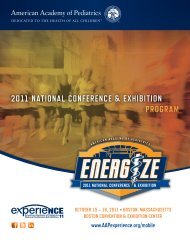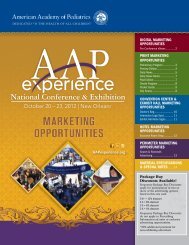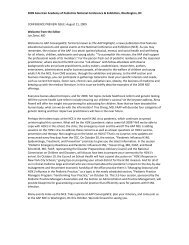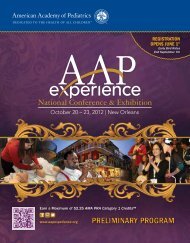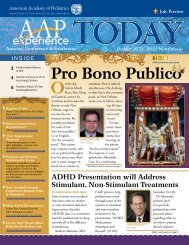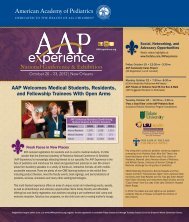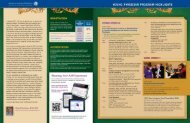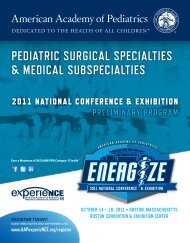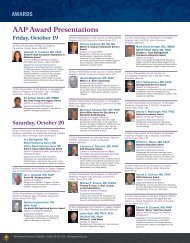heights - American Academy of Pediatrics National Conference ...
heights - American Academy of Pediatrics National Conference ...
heights - American Academy of Pediatrics National Conference ...
You also want an ePaper? Increase the reach of your titles
YUMPU automatically turns print PDFs into web optimized ePapers that Google loves.
Brief Summary: Based on full prescribing information revised April 2009.<br />
To report SUSPECTED ADVERSE REACTIONS, contact Bausch & Lomb<br />
Incorporated at 1-800-323-0000 or FDA at 1-800-FDA-1088 or www.fda.gov/<br />
medwatch.<br />
INDICATIONS AND USAGE<br />
Besivance (besifloxacin ophthalmic suspension) 0.6%, is indicated for the<br />
treatment <strong>of</strong> bacterial conjunctivitis caused by susceptible isolates <strong>of</strong> the<br />
following bacteria:<br />
CDC coryneform group G<br />
Corynebacterium pseudodiphtheriticum*<br />
Corynebacterium striatum*<br />
Haemophilus influenzae<br />
Moraxella lacunata*<br />
Staphylococcus aureus<br />
Staphylococcus epidermidis<br />
Staphylococcus hominis*<br />
Staphylococcus lugdunensis*<br />
Streptococcus mitis group<br />
Streptococcus oralis<br />
Streptococcus pneumoniae<br />
Streptococcus salivarius*<br />
*Efficacy for this organism was studied in fewer than 10 infections.<br />
DOSAGE AND ADMINISTRATION<br />
Invert closed bottle and shake once before use.<br />
Instill one drop in the affected eye(s) 3 times a day, four to twelve hours<br />
apart for 7 days.<br />
CONTRAINDICATIONS<br />
None<br />
WARNINGS AND PRECAUTIONS<br />
Topical Ophthalmic Use Only<br />
NOT FOR INJECTION INTO THE EYE.<br />
Besivance is for topical ophthalmic use only, and should not be injected<br />
subconjunctivally, nor should it be introduced directly into the anterior<br />
chamber <strong>of</strong> the eye.<br />
Growth <strong>of</strong> Resistant Organisms with Prolonged Use<br />
As with other anti-infectives, prolonged use <strong>of</strong> Besivance (besifloxacin<br />
ophthalmic suspension) 0.6% may result in overgrowth <strong>of</strong> non-susceptible<br />
organisms, including fungi. If super-infection occurs, discontinue use and<br />
institute alternative therapy. Whenever clinical judgment dictates, the patient<br />
should be examined with the aid <strong>of</strong> magnification, such as slit-lamp<br />
biomicroscopy, and, where appropriate, fluorescein staining.<br />
Avoidance <strong>of</strong> Contact Lenses<br />
Patients should not wear contact lenses if they have signs or symptoms <strong>of</strong><br />
bacterial conjunctivitis or during the course <strong>of</strong> therapy with Besivance.<br />
ADVERSE REACTIONS<br />
Because clinical trials are conducted under widely varying conditions, adverse<br />
reaction rates observed in one clinical trial <strong>of</strong> a drug cannot be directly<br />
compared with the rates in the clinical trials <strong>of</strong> the same or another drug and<br />
may not reflect the rates observed in practice.<br />
The data described below reflect exposure to Besivance in approximately<br />
1,000 patients between 1 and 98 years old with clinical signs and symptoms<br />
<strong>of</strong> bacterial conjunctivitis.<br />
The most frequently reported ocular adverse event was conjunctival redness,<br />
reported in approximately 2% <strong>of</strong> patients.<br />
Other adverse events reported in patients receiving Besivance occurring in<br />
approximately 1-2% <strong>of</strong> patients included: blurred vision, eye pain, eye<br />
irritation, eye pruritus and headache.<br />
USE IN SPECIFIC POPULATIONS<br />
Pregnancy<br />
Pregnancy Category C. Oral doses <strong>of</strong> besifloxacin up to 1000 mg/kg/day were<br />
not associated with visceral or skeletal malformations in rat pups in a study <strong>of</strong><br />
embryo-fetal development, although this dose was associated with maternal<br />
toxicity (reduced body weight gain and food consumption) and maternal<br />
mortality. Increased post-implantation loss, decreased fetal body weights, and<br />
decreased fetal ossification were also observed. At this dose, the mean C max<br />
in the rat dams was approximately 20 mcg/mL, >45,000 times the mean<br />
plasma concentrations measured in humans. The No Observed Adverse Effect<br />
Level (NOAEL) for this embryo-fetal development study was 100 mg/kg/day<br />
(C max, 5 mcg/mL, >11,000 times the mean plasma concentrations measured in<br />
humans).<br />
In a prenatal and postnatal development study in rats, the NOAELs for both<br />
fetal and maternal toxicity were also 100 mg/kg/day. At 1000 mg/kg/day,<br />
the pups weighed significantly less than controls and had a reduced neonatal<br />
survival rate. Attainment <strong>of</strong> developmental landmarks and sexual maturation<br />
were delayed, although surviving pups from this dose group that were reared<br />
to maturity did not demonstrate deficits in behavior, including activity,<br />
learning and memory, and their reproductive capacity appeared normal.<br />
Since there are no adequate and well-controlled studies in pregnant women,<br />
Besivance should be used during pregnancy only if the potential benefit<br />
justifies the potential risk to the fetus.<br />
Nursing Mothers<br />
Besifloxacin has not been measured in human milk, although it can be<br />
presumed to be excreted in human milk. Caution should be exercised when<br />
Besivance is administered to a nursing mother.<br />
Pediatric Use<br />
The safety and effectiveness <strong>of</strong> Besivance in infants below one year <strong>of</strong> age<br />
have not been established. The efficacy <strong>of</strong> Besivance in treating bacterial<br />
conjunctivitis in pediatric patients one year or older has been demonstrated<br />
in controlled clinical trials [see 14 CLINICAL STUDIES].<br />
There is no evidence that the ophthalmic administration <strong>of</strong> quinolones has any<br />
effect on weight bearing joints, even though systemic administration <strong>of</strong> some<br />
quinolones has been shown to cause arthropathy in immature animals.<br />
Geriatric Use<br />
No overall differences in safety and effectiveness have been observed<br />
between elderly and younger patients.<br />
NONCLINICAL TOXICOLOGY<br />
Carcinogenesis, Mutagenesis, Impairment Of Fertility<br />
Long-term studies in animals to determine the carcinogenic potential <strong>of</strong><br />
besifloxacin have not been performed.<br />
No in vitro mutagenic activity <strong>of</strong> besifloxacin was observed in an Ames test<br />
(up to 3.33 mcg/plate) on bacterial tester strains Salmonella typhimurium<br />
TA98, TA100, TA1535, TA1537 and Escherichia coli WP2uvrA. However, it was<br />
mutagenic in S. typhimurium strain TA102 and E. coli strain WP2(pKM101).<br />
Positive responses in these strains have been observed with other quinolones<br />
and are likely related to topoisomerase inhibition.<br />
Besifloxacin induced chromosomal aberrations in CHO cells in vitro and it was<br />
positive in an in vivo mouse micronucleus assay at oral doses 1500 mg/kg.<br />
Besifloxacin did not induce unscheduled DNA synthesis in hepatocytes<br />
cultured from rats given the test compound up to 2,000 mg/kg by the oral<br />
route. In a fertility and early embryonic development study in rats,<br />
besifloxacin did not impair the fertility <strong>of</strong> male or female rats at oral doses <strong>of</strong><br />
up to 500 mg/kg/day. This is over 10,000 times higher than the<br />
recommended total daily human ophthalmic dose.<br />
PATIENT COUNSELING INFORMATION<br />
Patients should be advised to avoid contaminating the applicator tip with<br />
material from the eye, fingers or other source.<br />
Although Besivance is not intended to be administered systemically,<br />
quinolones administered systemically have been associated with<br />
hypersensitivity reactions, even following a single dose. Patients should be<br />
advised to discontinue use immediately and contact their physician at the first<br />
sign <strong>of</strong> a rash or allergic reaction.<br />
Patients should be told that although it is common to feel better early in the<br />
course <strong>of</strong> the therapy, the medication should be taken exactly as directed.<br />
Skipping doses or not completing the full course <strong>of</strong> therapy may (1) decrease<br />
the effectiveness <strong>of</strong> the immediate treatment and (2) increase the likelihood<br />
that bacteria will develop resistance and will not be treatable by Besivance<br />
or other antibacterial drugs in the future.<br />
Patients should be advised not to wear contact lenses if they have signs or<br />
symptoms <strong>of</strong> bacterial conjunctivitis or during the course <strong>of</strong> therapy with<br />
Besivance.<br />
Patients should be advised to thoroughly wash hands prior to using<br />
Besivance.<br />
Patients should be instructed to invert closed bottle (upside down) and shake<br />
once before each use. Remove cap with bottle still in the inverted position.<br />
Tilt head back, and with bottle inverted, gently squeeze bottle to instill one<br />
drop into the affected eye(s).<br />
Manufactured by: Bausch & Lomb Incorporated<br />
Tampa, Florida 33637<br />
©Bausch & Lomb Incorporated<br />
U.S. Patent No. 6,685,958<br />
U.S. Patent No. 6,699,492<br />
U.S. Patent No. 5,447,926<br />
Besivance is a trademark <strong>of</strong> Bausch & Lomb Incorporated<br />
*DuraSite is a trademark <strong>of</strong> InSite Vision Incorporated<br />
April 2009 9159600



